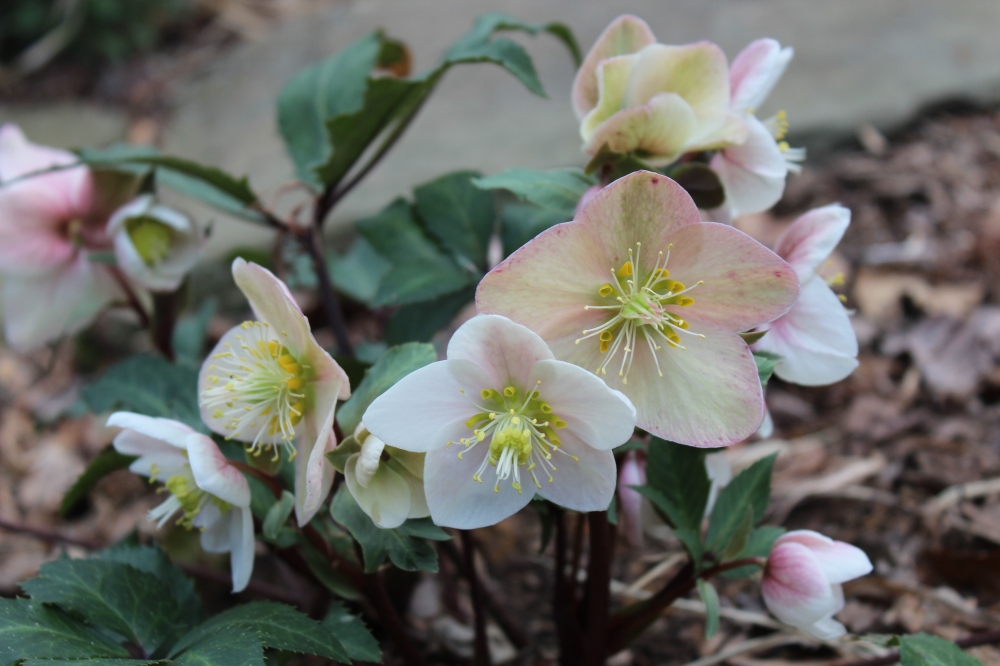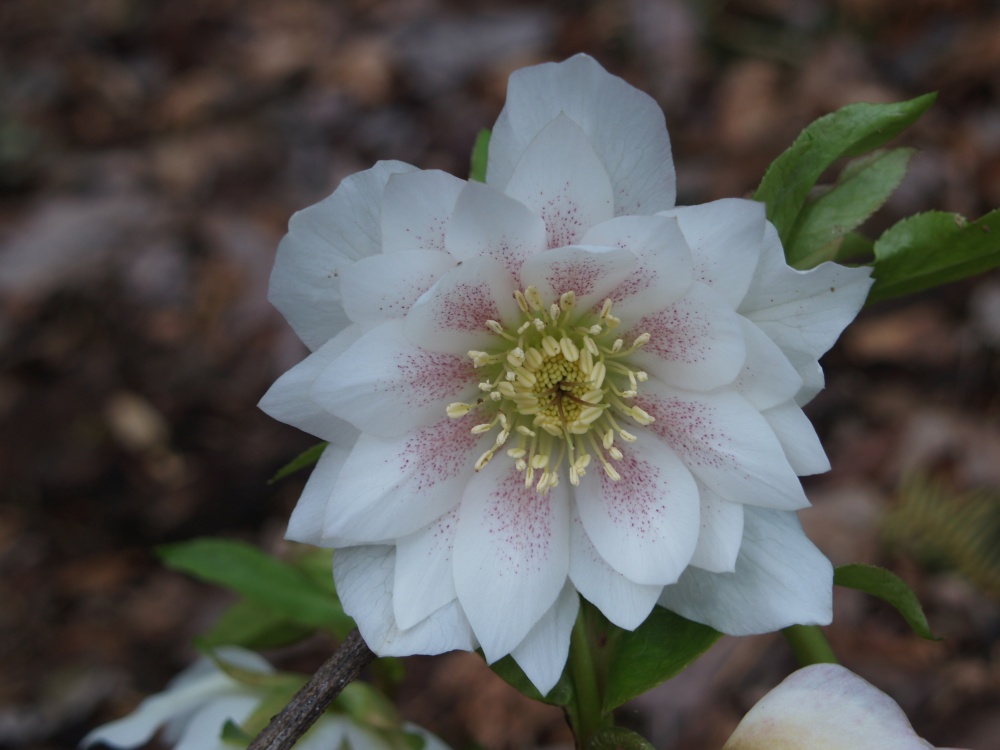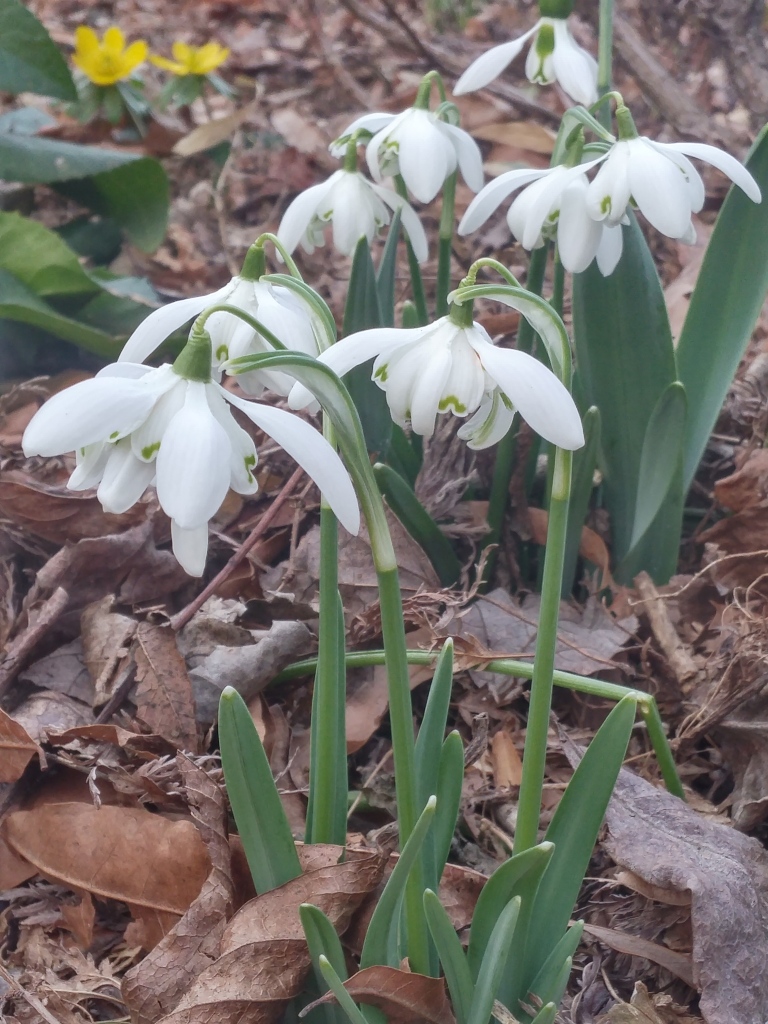I suspect that I am not the only gardener who has gotten a jump on his spring cleanup. In a more typical winter, with only a few spells of warmth I am likely to waste the days in less productive pursuits, and this was true until a few weeks ago. Now, the early weeks of spring must not be consumed by endless labor, though in this one acre garden there is never a lack of chores that must be accomplished.
I must report on the casual research regarding squirrels and our birdfeeder. Possibly, the feeding habits of neighborhood squirrels are too ingrained, and they are too dependent on this accessible feeder. The addition of pepper seasoning to sunflower seed was a temporary discouragement, but a subsequent change to safflower seed was most successful. But, not completely, as several squirrels visit daily, though clearly for shorter feeding sessions.
I cannot recall a time when so many hellebores were flowering at this date. Certainly, there have been recent years when they bloomed earlier, with flowers fading with the occasional freeze in February, which of course have been rare this winter. I note a few hellebore seedlings that were transplanted are flowering, probably two years after they were large enough to move. Flowers of some are identical to those of parent plants, while others are a somewhat interesting pink, though this color is not so outstanding that I would choose it off the garden center shelf.
I once read a gardener’s claim that hellebores should be considered as invasive, and yes, some seed vigorously, but it seems the only hazard is that seedlings might overwhelm the original clump. In a few plantings, yellow-green flowers mix with dark purple, but in recent years I’ve weeded excess seedlings out to let the few grow on, and then these are transplanted in their second year. If the day comes when the garden is overrun, I expect that family and neighbors will willingly accept the excess.
Happily, now that most all of the snowdrops are up and blooming, it is apparent that these are multiplying nicely along the driveway and the front walk. None are where they might be seen from the road, even as neighbors walk by on mild February afternoons. Few winter flowers are borne in such mass as to be as obvious as an azalea or a cherry, so the gardener should be forgiven for arranging flower only for his enjoyment, and not sharing. If neighbors care to tour the garden, with an early start cleaning up, it’s as good as it gets for late winter.
Hi there from another gardener who is using this strange warmth to do some garden cleanup and watching so many things blooming already. I planted hellebores last year for the first time and after I did it someone just had to tell me “they’re invasive!” Well, shoot! So I really really appreciate your suggestions how to control and to weed out the seedlings around the parents plants to avoid overcrowding. I am enjoying them with their subtle whites, creams and pinks and will probably plant more because they seem to happy under my oak trees. At least something will bloom in that shade! Thank you again for the advice!
Your hellebores are beautiful. Yes they are invasive; but I don’t care. I just weed out the seedlings. And I have lots of plants to give my gardening friends. I have some that nature planted in places I would never been able to plant them and they look wonderful. There is one that came up across from the kitchen window. I look forward to it blooming every year.
The criteria for invasives is that the plant will displace another. While I’ve had seedlings nestle right up to the trunk of a dogwood, and another pop up in a wide spreading clump of Gold Star, there seems no danger that hellebores will take over. Besides seedlings that sprout beside the parent plants, I find others where seed has washed downhill, but none are in a hurry to take over.
Get a squirrel-proof feeder! We have a ground mounted feeder bought from Kinsman Garden Company. Problem solved!
Yes, I’ve heard this before, like every time my wife sees a squirrel at the feeder. The feeder choice was made for aesthetics, not utility, but now I think we’ve reached an acceptable balance.
Question: a few years ago I planted 100 daffodils together…..they were beautiful and made quite a statement. Now they are coming up in different places . What does this?
I have no recollection of planting cyclamen just beside the front walk, but there they are. This is my poor memory, which is partially excused because of the size of the garden. Certainly, this is not the issue with the daffodils. Though they are poisonous, it is possible that squirrels dug the bulbs, and carried them to the new location. Bulbs can wander a bit on their own, but not far.
Dave, I have what amounts to quarter acre of gardens surrounding my one acre plot. Mulching has become an expensive proposition to the tuNE of 900.00 every time I mulch with me slinging it! Any suggestions?
I’m probably a bad one to ask since after the initial planting I don’t mulch ever again. To save money I mulch with bark chunks, which decay much more slowly, though some mulch floats away in rainwater runoff. In areas where leaves fall, I shred them or leave them whole, and spread them around. The best idea is to cover as much ground with plants as possible. In open areas, and beneath trees and shrubs, low growing plants will fill spaces, look considerably better than mulch, and cut the amount of mulch that is needed. This can be done with perennials or even fast growing annuals.
This is fantastic Dave, now I don’t have to send my photos to my Aunt to identify them. Yes, I should know all the names by now.